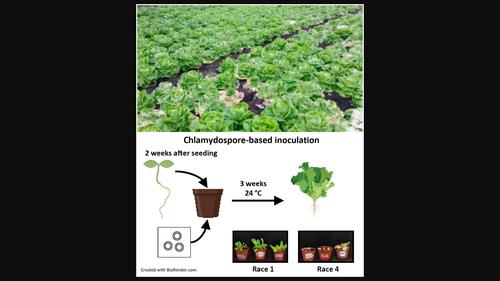当前位置:
X-MOL 学术
›
Plant Pathol.
›
论文详情
Our official English website, www.x-mol.net, welcomes your
feedback! (Note: you will need to create a separate account there.)
Fusarium isolates from Belgium causing wilt in lettuce show genetic and pathogenic diversity
Plant Pathology ( IF 2.3 ) Pub Date : 2022-11-04 , DOI: 10.1111/ppa.13668 Jolien Claerbout 1, 2, 3 , Kris Van Poucke 2 , Hanna Mestdagh 1, 2 , Ilse Delaere 1 , Isabel Vandevelde 4 , Sofie Venneman 4 , An Decombel 3 , Peter Bleyaert 3, 5 , Jenny Neukermans 6, 7 , Nicole Viaene 2, 8 , Kurt Heungens 2 , Monica Höfte 1
Plant Pathology ( IF 2.3 ) Pub Date : 2022-11-04 , DOI: 10.1111/ppa.13668 Jolien Claerbout 1, 2, 3 , Kris Van Poucke 2 , Hanna Mestdagh 1, 2 , Ilse Delaere 1 , Isabel Vandevelde 4 , Sofie Venneman 4 , An Decombel 3 , Peter Bleyaert 3, 5 , Jenny Neukermans 6, 7 , Nicole Viaene 2, 8 , Kurt Heungens 2 , Monica Höfte 1
Affiliation

|
Fusarium oxysporum f. sp. lactucae race 4 causes vascular necrosis and wilting of lettuce. First observed in Belgium in 2015, the lack of disease resistance in commercial cultivars allowed this pathogen to spread to nearly the entire Belgian production area within 4 years. Different levels of disease development were observed in different commercial greenhouses. To help explain this variation, we collected 78 Fusarium isolates and characterized them both physiologically and genetically. Molecular race identification indicated that 91% of the isolates belonged to race 4, while 6% of the isolates belonged to race 1, which was not previously reported in Belgium. Pathogenicity assays using differential cultivars confirmed the molecular race assignment of selected isolates. Cultivar Patriot was identified as a suitable new differential cultivar to race 4. Race 4 isolates were more aggressive than race 1 isolates at 24°C, but only when using chlamydospore inoculum instead of a root dip assay containing microconidia. Variation in pathogenicity and aggressiveness of the races may explain differences in disease development in commercial greenhouses. Based on genotyping-by-sequencing (GBS), race 1 and race 4 isolates were highly similar to reference isolates. Fusarium curvatum, F. oxysporum f. sp. tulipae and F. oxysporum f. sp. rhois were phylogenetically separated from F. oxysporum f. sp. lactucae races 1 and 4 based on the GBS data, but not when using multilocus sequence data. Within F. oxysporum f. sp. lactucae race 4, the GBS data differentiated two rather homogeneous groups, suggesting at least two introductions. However, the two groups did not differ in aggressiveness.
中文翻译:

导致生菜枯萎的比利时镰刀菌表现出遗传和致病多样性
Fusarium oxysporum f. sp。lactucae race 4 导致生菜血管坏死和萎蔫。2015 年首次在比利时观察到,商业品种缺乏抗病性使得这种病原体在 4 年内传播到几乎整个比利时产区。在不同的商业温室中观察到不同程度的疾病发展。为了帮助解释这种变异,我们收集了 78 株镰刀菌从生理学和遗传学上分离和表征它们。分子种族鉴定表明,91% 的分离株属于种族 4,而 6% 的分离株属于种族 1,这在比利时以前没有报道过。使用差异栽培品种的致病性测定证实了所选分离株的分子种族分配。栽培品种爱国者被确定为适合第 4 种的新差异栽培品种。第 4 种分离株在 24°C 时比第 1 种分离株更具侵略性,但仅当使用厚膜孢子接种物而不是含有小分生孢子的根浸试验时。种群致病性和攻击性的差异可以解释商业温室中疾病发展的差异。基于基因分型测序 (GBS),种族 1 和种族 4 分离株与参考分离株高度相似。镰刀菌,F . 尖孢子菌f. sp。郁金香和F. _ 尖孢子菌f. sp。rhois在系统发育上与F分离。尖孢子菌f. sp。lactucae种族 1 和 4 基于 GBS 数据,但在使用多位点序列数据时不是。在F内。尖孢子菌f. sp。lactucae种族 4,GBS 数据区分了两个相当同质的群体,表明至少有两个介绍。然而,两组在侵略性上没有差异。
更新日期:2022-11-04
中文翻译:

导致生菜枯萎的比利时镰刀菌表现出遗传和致病多样性
Fusarium oxysporum f. sp。lactucae race 4 导致生菜血管坏死和萎蔫。2015 年首次在比利时观察到,商业品种缺乏抗病性使得这种病原体在 4 年内传播到几乎整个比利时产区。在不同的商业温室中观察到不同程度的疾病发展。为了帮助解释这种变异,我们收集了 78 株镰刀菌从生理学和遗传学上分离和表征它们。分子种族鉴定表明,91% 的分离株属于种族 4,而 6% 的分离株属于种族 1,这在比利时以前没有报道过。使用差异栽培品种的致病性测定证实了所选分离株的分子种族分配。栽培品种爱国者被确定为适合第 4 种的新差异栽培品种。第 4 种分离株在 24°C 时比第 1 种分离株更具侵略性,但仅当使用厚膜孢子接种物而不是含有小分生孢子的根浸试验时。种群致病性和攻击性的差异可以解释商业温室中疾病发展的差异。基于基因分型测序 (GBS),种族 1 和种族 4 分离株与参考分离株高度相似。镰刀菌,F . 尖孢子菌f. sp。郁金香和F. _ 尖孢子菌f. sp。rhois在系统发育上与F分离。尖孢子菌f. sp。lactucae种族 1 和 4 基于 GBS 数据,但在使用多位点序列数据时不是。在F内。尖孢子菌f. sp。lactucae种族 4,GBS 数据区分了两个相当同质的群体,表明至少有两个介绍。然而,两组在侵略性上没有差异。















































 京公网安备 11010802027423号
京公网安备 11010802027423号